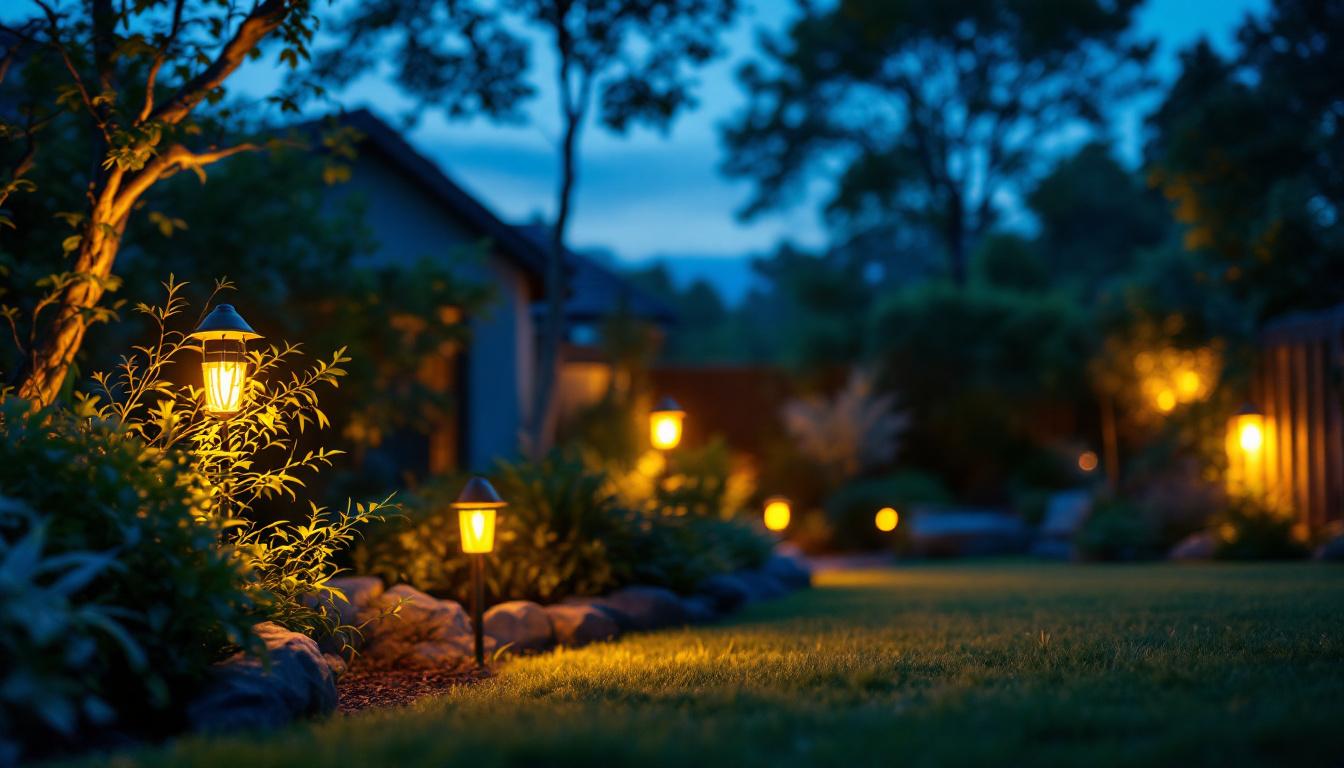
In the realm of outdoor landscape lighting, the 120-volt systems are a popular choice among contractors for their versatility and effectiveness. However, navigating the complexities of installation, design, and maintenance can be challenging. This article aims to provide valuable hacks and insights specifically tailored for smart lighting contractors, enabling them to enhance their projects and streamline their processes.
Before diving into practical hacks, it’s crucial to understand the fundamentals of 120-volt outdoor landscape lighting systems. These systems are typically connected to standard household electrical circuits, making them suitable for a variety of applications, from illuminating pathways to accentuating architectural features.
One of the primary advantages of 120-volt systems is their ability to deliver brighter lighting compared to low-voltage alternatives. This makes them ideal for areas that require significant illumination, such as driveways and large gardens. Additionally, the installation of 120-volt systems often allows for the use of more powerful fixtures, which can enhance the overall aesthetic appeal of a landscape.
Moreover, 120-volt systems can be integrated with smart technology, enabling contractors to offer clients advanced features such as remote control, dimming options, and programmable schedules. This integration not only improves user experience but also adds value to the contractor’s service offerings. Homeowners can easily adjust their outdoor lighting to suit different occasions, whether it’s a festive gathering or a quiet evening at home, enhancing both functionality and ambiance.
While 120-volt systems offer numerous benefits, safety must always be a top priority. It’s essential to adhere to local electrical codes and regulations when installing these systems. Proper grounding and circuit protection are critical to prevent electrical hazards. Contractors should also ensure that all fixtures and wiring are rated for outdoor use to withstand environmental conditions.
Regular maintenance checks should be conducted to identify any potential issues, such as frayed wires or water ingress in fixtures. Educating clients about the importance of safety and maintenance can also foster trust and reliability in the contractor-client relationship. Additionally, it’s wise to inform clients about the potential risks associated with DIY installations, as improper handling of electrical components can lead to serious accidents. By emphasizing the importance of professional installation and ongoing maintenance, contractors can help ensure that clients enjoy their outdoor lighting systems safely and effectively for years to come.
Designing an effective outdoor lighting scheme requires a thoughtful approach that balances aesthetics and functionality. Here are some hacks to optimize landscape lighting design using 120-volt systems.
One of the most effective design techniques is layering light. This involves using a combination of ambient, task, and accent lighting to create depth and dimension in outdoor spaces. Ambient lighting provides general illumination, while task lighting focuses on specific areas, such as pathways or seating areas. Accent lighting highlights architectural features or landscaping elements, adding visual interest.
By strategically placing different types of fixtures, contractors can create a harmonious lighting scheme that enhances the beauty of the landscape while ensuring safety and functionality. For instance, using wall-mounted fixtures for ambient light, path lights for task illumination, and spotlights for accenting trees or sculptures can create a well-rounded lighting experience. Additionally, consider the use of dimmable fixtures to allow for flexibility in mood and atmosphere, enabling homeowners to adjust the brightness according to the occasion, whether it’s a lively gathering or a quiet evening under the stars.
Incorporating smart controls into landscape lighting designs can significantly enhance user convenience. By utilizing smart switches, dimmers, and timers, contractors can offer clients the ability to customize their lighting experience. For instance, programmable schedules can ensure that lights turn on and off at specific times, providing security and energy savings.
Additionally, integrating smart home systems can allow clients to control their outdoor lighting through mobile apps or voice commands. This level of control not only appeals to tech-savvy homeowners but also positions contractors as forward-thinking professionals in the industry. Moreover, smart lighting can be integrated with motion sensors, automatically illuminating pathways when someone approaches, which not only enhances safety but also adds an element of surprise and delight for guests. The ability to sync outdoor lighting with weather patterns or seasonal changes can further personalize the experience, allowing for dynamic displays that reflect the beauty of nature throughout the year.
The selection of fixtures plays a critical role in the overall success of a landscape lighting project. When working with 120-volt systems, it’s essential to choose fixtures that are not only aesthetically pleasing but also durable and weather-resistant. Look for materials such as stainless steel or aluminum, which can withstand outdoor conditions without corroding.
Moreover, consider the color temperature of the fixtures. Warmer tones (2700K to 3000K) tend to create a welcoming atmosphere, while cooler tones (4000K and above) can provide a more modern look. Matching the color temperature to the intended ambiance can greatly enhance the overall effect of the lighting design. Additionally, the style of the fixtures should complement the architecture of the home and the surrounding landscape. For instance, sleek, minimalist fixtures may suit contemporary homes, while ornate lanterns can enhance traditional settings. It’s also wise to think about the beam spread of the fixtures; narrow beams can create dramatic highlights, while wider beams provide softer, more diffused light that can illuminate larger areas effectively. By carefully selecting fixtures that align with both functional needs and aesthetic preferences, contractors can elevate the overall impact of their lighting designs.
Efficient installation is key to ensuring that landscape lighting projects are completed on time and within budget. Here are some practical hacks that can help streamline the installation process.
Before beginning any installation, it’s beneficial to pre-plan the layout of the lighting system. This includes determining the placement of fixtures, the routing of wiring, and the location of power sources. Using design software or simple sketches can help visualize the project and identify potential challenges early on.
Additionally, conducting a site assessment can provide valuable insights into how natural light interacts with the landscape. Understanding the existing conditions will allow contractors to make informed decisions about fixture placement and lighting intensity.
Incorporating quick-connect systems can significantly reduce installation time. These systems allow for faster connections between fixtures and wiring, minimizing the need for complex splicing. Many modern fixtures come equipped with plug-and-play connectors, making it easier to install and replace fixtures without extensive rewiring.
Moreover, using modular components can enhance flexibility in design. If a client decides to expand their lighting system in the future, modular components can be easily added without needing a complete overhaul of the existing setup.
Proper labeling of wires and fixtures can save time and prevent confusion during installation and future maintenance. Contractors should develop a labeling system that clearly identifies each fixture and its corresponding power source. This practice not only aids in installation but also simplifies troubleshooting and repairs down the line.
Additionally, maintaining thorough documentation of the installation process, including diagrams and specifications, can be invaluable for future reference. This documentation can serve as a guide for maintenance or potential upgrades, ensuring that both the contractor and the client have a clear understanding of the system.
Once the installation is complete, ongoing maintenance is essential to ensure the longevity and performance of the landscape lighting system. Here are some tips to help contractors provide excellent maintenance services.
Conducting regular inspections of the lighting system is crucial for identifying potential issues before they become significant problems. Contractors should schedule routine checks to assess the condition of fixtures, wiring, and connections. Look for signs of wear, such as rust or corrosion, and replace any damaged components promptly.
Additionally, checking the alignment and positioning of fixtures can help maintain optimal lighting performance. Over time, fixtures may become misaligned due to weather conditions or landscaping changes, affecting their effectiveness.
Keeping fixtures clean is essential for maintaining their appearance and functionality. Dust, dirt, and debris can accumulate on fixtures, reducing their light output and aesthetic appeal. Contractors should recommend regular cleaning schedules to clients, emphasizing the importance of using appropriate cleaning solutions that won’t damage the fixtures.
Furthermore, ensuring that landscaping elements, such as plants and trees, do not obstruct light paths is crucial. Regular trimming and maintenance of surrounding vegetation can help maintain the intended lighting effect and prevent light pollution.
Educating clients about the importance of maintenance can foster a sense of responsibility and partnership. Providing clients with a maintenance guide that outlines best practices, such as when to clean fixtures or how to check for electrical issues, can empower them to take an active role in caring for their landscape lighting system.
Offering maintenance services as part of the contractor’s portfolio can also create ongoing relationships with clients, leading to repeat business and referrals. By positioning maintenance as an essential aspect of the overall service, contractors can enhance their reputation and client satisfaction.
In the competitive field of outdoor landscape lighting, contractors must continuously seek ways to improve their skills and service offerings. By understanding the intricacies of 120-volt systems, employing effective design strategies, streamlining installation processes, and prioritizing maintenance, contractors can elevate their projects and ensure client satisfaction.
Implementing these hacks not only enhances the quality of the work but also positions contractors as knowledgeable professionals in the industry. As technology continues to evolve, staying informed and adaptable will be key to thriving in the world of outdoor landscape lighting.
Ready to take your outdoor landscape lighting projects to the next level? At LumenWholesale, we provide smart lighting contractors like you with the highest quality, spec-grade lighting products at prices that can’t be beaten. Say goodbye to local distributor markups and hello to a vast selection of reliable lighting that meets rigorous industry standards. Plus, with free shipping on bulk orders, you can stock up on everything you need while keeping your costs down. Elevate your lighting game with the perfect combination of quality, affordability, and convenience. Wholesale Lighting at the Best Value is just a click away!

Discover everything lighting contractors need to know about solar lights clearance sales in just five minutes.

Discover the essential guide to electric wire connectors tailored for lighting contractors.

Discover the common pitfalls lighting contractors face when installing under unit kitchen lights.

Discover why light switch timers are essential tools for lighting contractors.